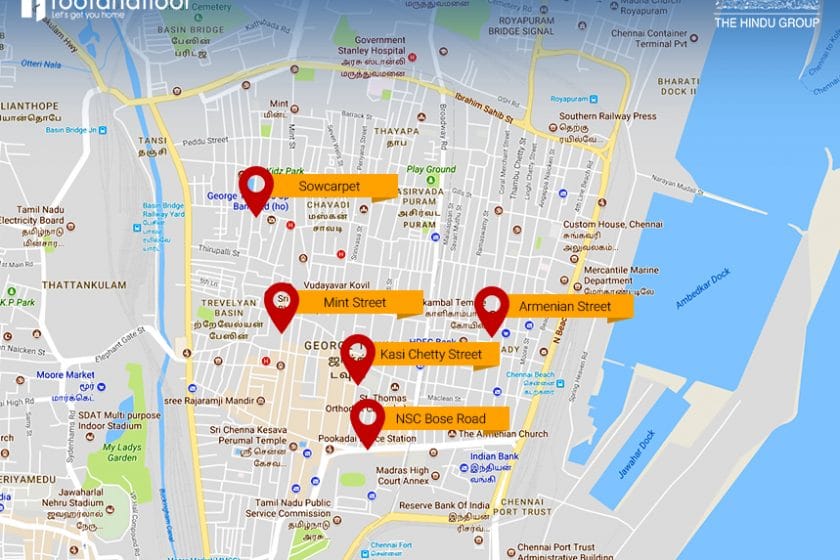Chennai is rife with buildings that stir memories of the British era and it continues to attract many visitors with its Raj hangover.
George Town, or Muthialpet as it was known once upon a time, is one such locality that attracts not just international tourists but also continue to be fascinating for locals as well.
The story of George Town
George Town was originally known as Black Town in the 1600s by the British as it was an area predominantly populated by Indians. It was here that the first settlement of Madras was set up and also housed the East India Company’s warehouse. As the area expanded with trade, it became the centre for construction and development activities, including one of the major ports of Madras.
In the 18th century, the French returned Madras, after a brief occupation, to the English who razed a part of the Black Town to defend themselves against further attacks. They erected 13 pillars a short distance away from the fort and banned any construction in the space between. Soon, a new Black Town came up and later, the Madras High Court was set up at this location. Today, only one pillar remains and this is preserved within the walls of Parry’s building.
By the 1960s, the population had completely changed. Tamil refugees from Burma arrived and settled down in the area, giving rise to the present day Burma Bazaar, which sold imported products.
In order to take in George Town’s rich history a leisurely walk in the area is a must. Here are the top five streets of George Town that will keep you enthralled for the better part of the day.
NSC Bose Road or China Bazaar Road
NSC Bose Road is popularly known as China Bazaar Road and connects Rajaji Salai and Wall Tax Road on two sides. In the 18th century, a Welsh businessman named Thomas Parry bought a large house as well as commercial buildings for his businesses.
Today, Parry’s Corner is a famous landmark along with Pachaiyappa’s Hall named after the renowned dubash and one of the richest men in Chennai during the 18th century, Pachaiyappa Mudaliar.
China Bazaar Road is also known for being the area where trams were first set up in the 19th century and for housing one of the largest markets in Asia during the time named Kothawal Chavadi. A walk down the road beginning from Parry’s Corner will take you past landmarks like the Madras High Court, Kothawal Chavadi, the twin temples of Chenna Mallikeshwarar and Chennakesava Perumal dating back to the 18th century. This is one of the busiest shopping districts of Chennai and you can buy everything from wholesale fabrics to cosmetics to utensils.
Kasi Chetty Street
Have to choose a gift? Come to Kasi Chetty Street where row upon row of tiny shops are lined up selling imported goods. You can find toys, perfumes, bags, electronics etc and even imported fabrics that attract would-be brides.
Mint Street
The origins of this street goes back to the 17th century when a Jewish cemetery existed here. Later, in the 18th century, the road was predominantly occupied by the washers who worked for the East India Company’s clothing business.
Then known as Washers’ Street, the demographic profile slowly changed in the subsequent years when textile traders from Gujarat settled down in the area. Then in the 19th century, the East India Company established its currency minting facility on this street giving it its present name.
Mint Street also housed one of the oldest cinema theatres in the city.
Come to Mint Street today and as you take in some of the history of Madras step into one of the many Rajasthani eateries that it is known for.
Armenian Street
This is one of the most historical streets of Chennai and is locally known as Aranmanaikaran Street.
Connecting Mannady Street and China Bazaar Street on two ends, the street is named for the Armenians who came to Madras and settled in the area around the 1750s. The Armenians were wealthy and traded in silk, spices and gems.
Even today, you can see historically relevant buildings like the Armenian Church, the St Mary’s Co Cathedral, and the St Mary’s Anglo-Indian Higher Secondary School, which is one of the oldest in India.
Sowcarpet
Sowcarpet is, of course, the North Indian hub of Chennai. Known for its snacks stalls, saris, men’s and women’s traditional outfits, Sowcarpet is a shopper’s paradise. You can finish all your shopping on this single street and then wend your way through the heaving crowds towards the numerous chaat shops and small eateries serving traditional Gujarati and Marwari fare.


